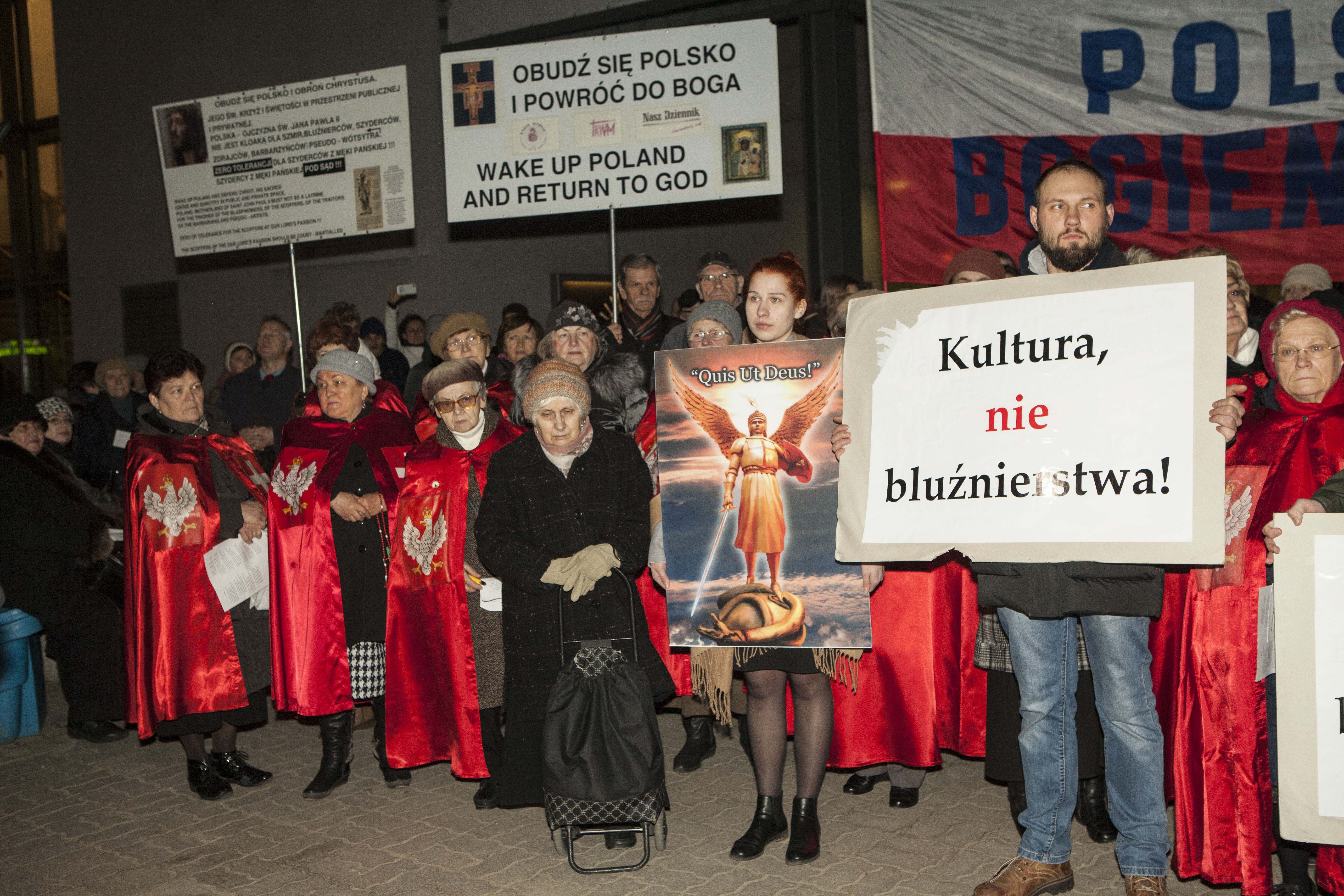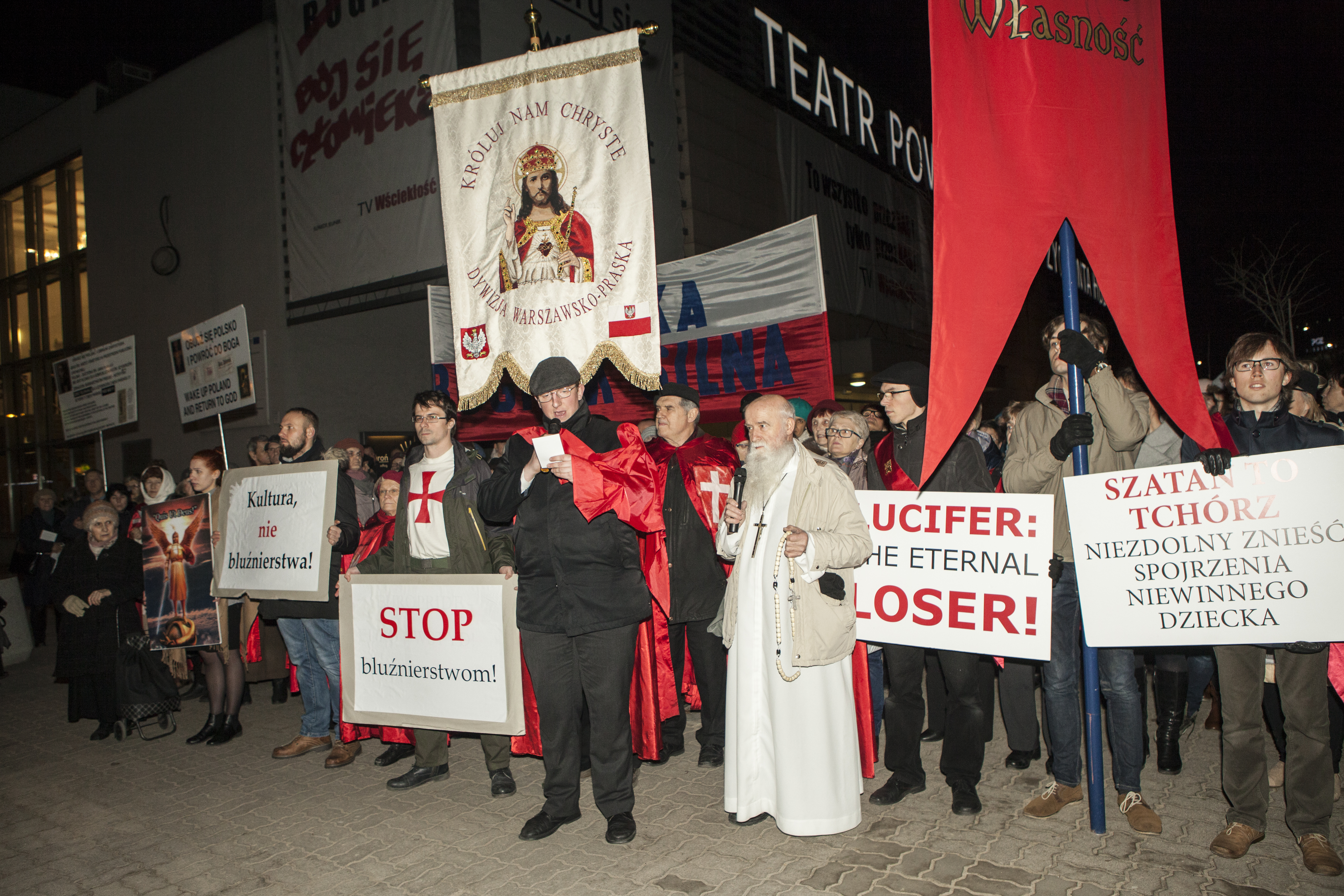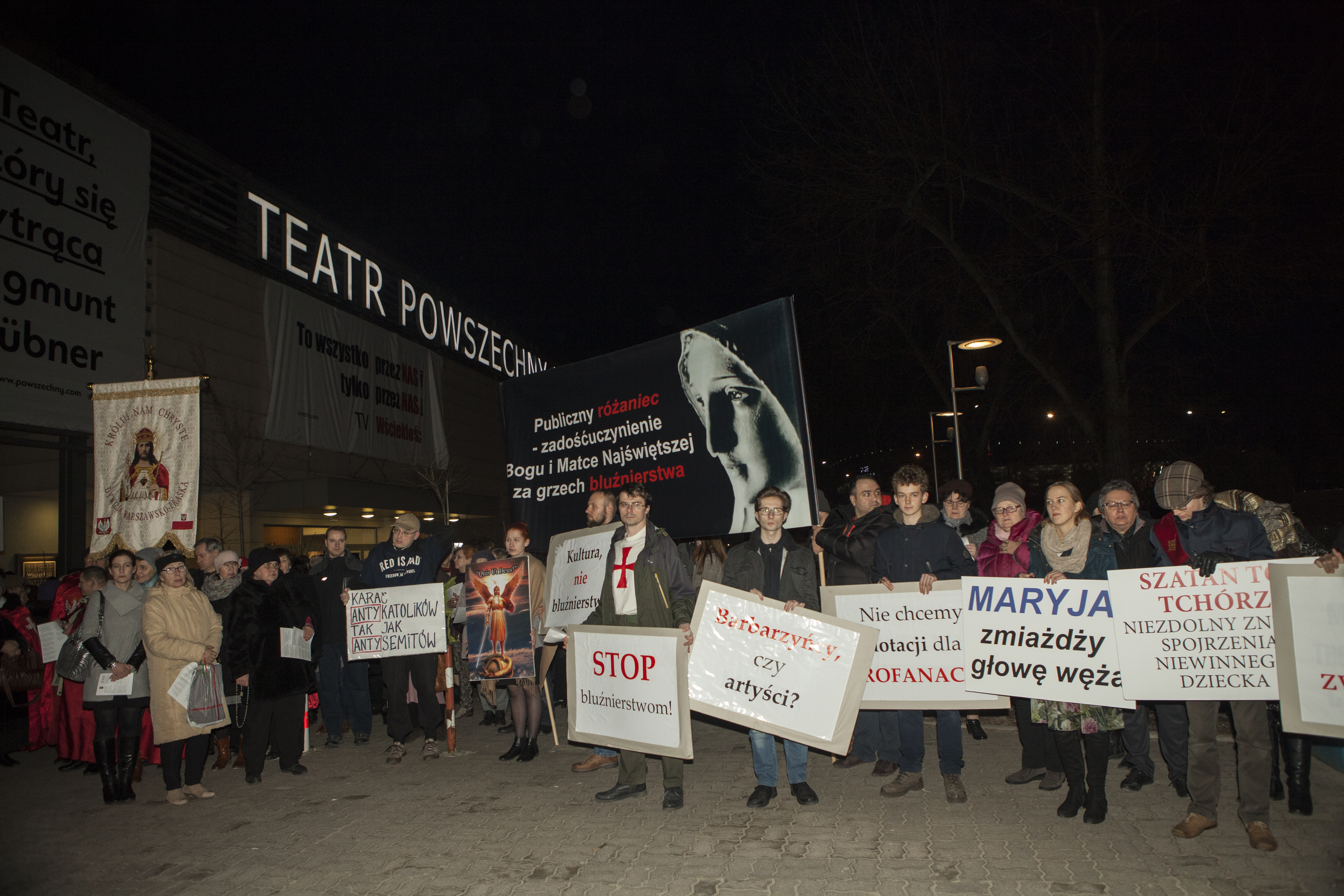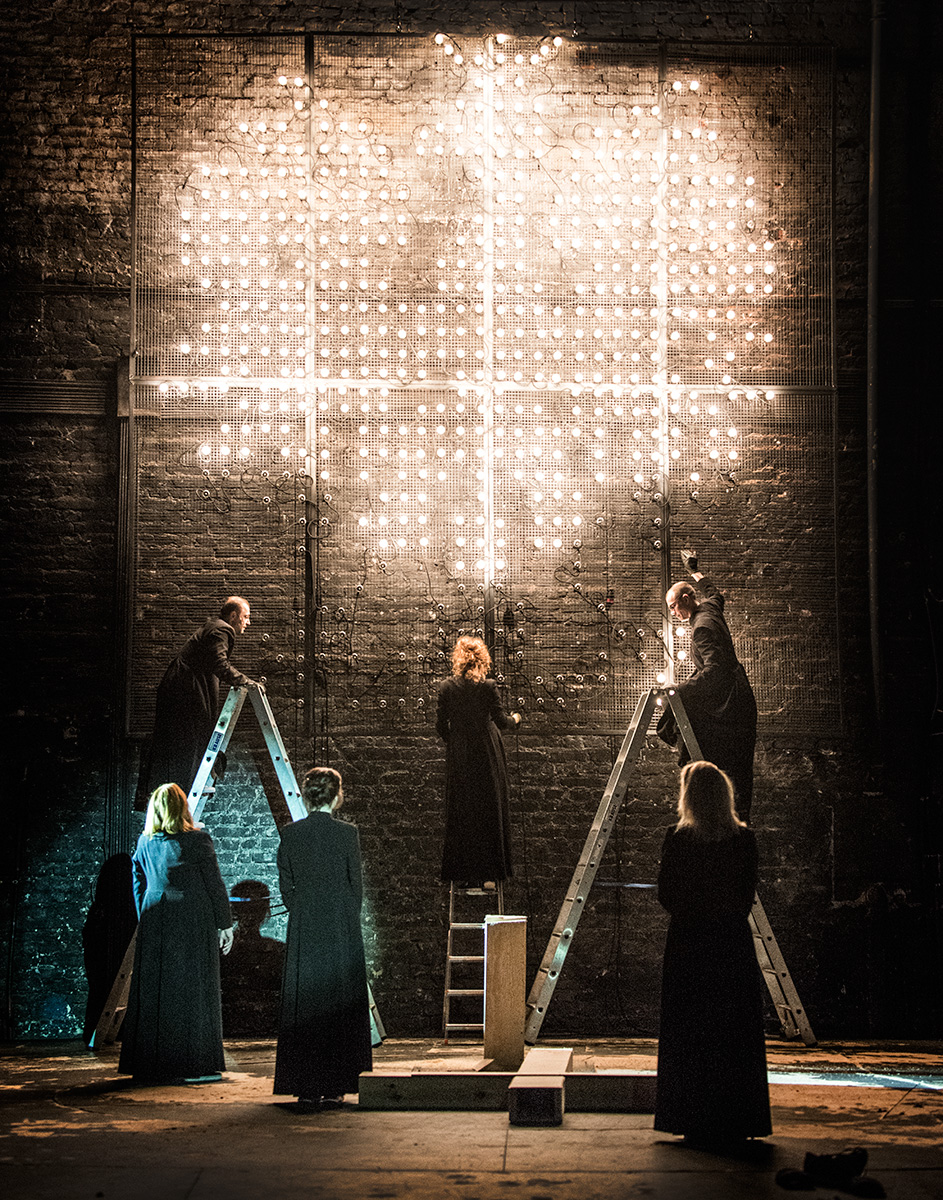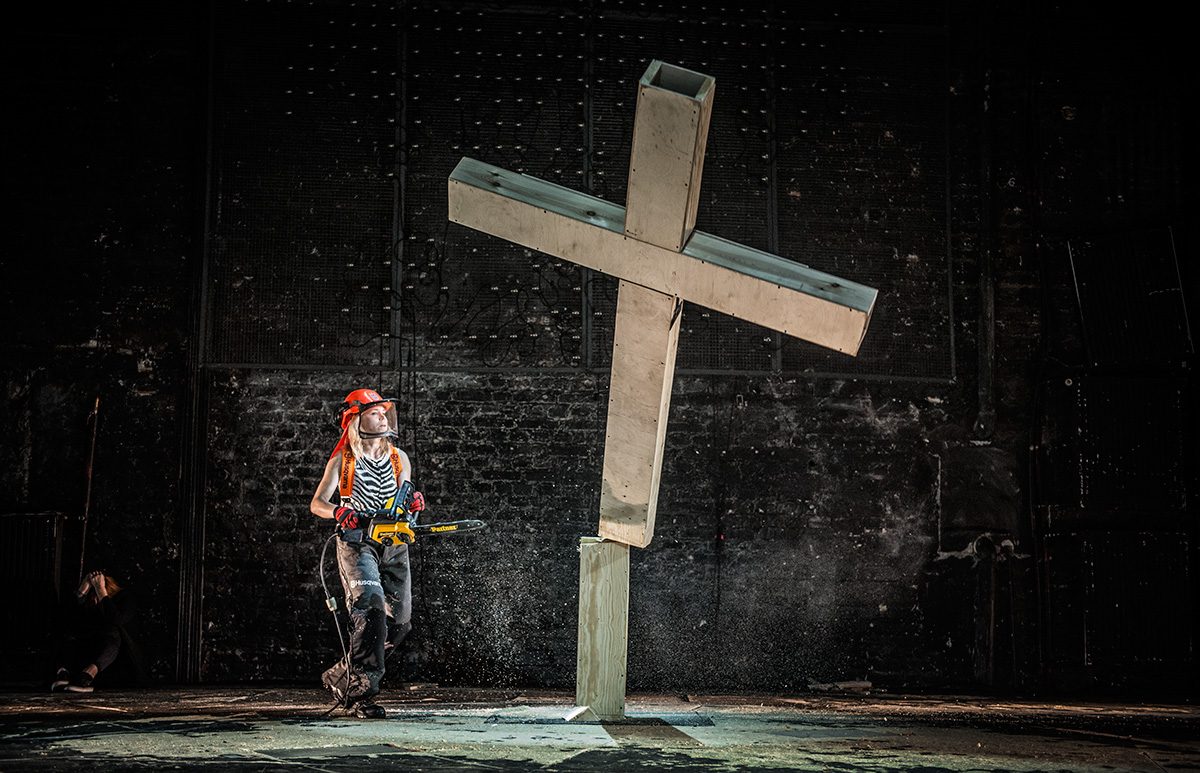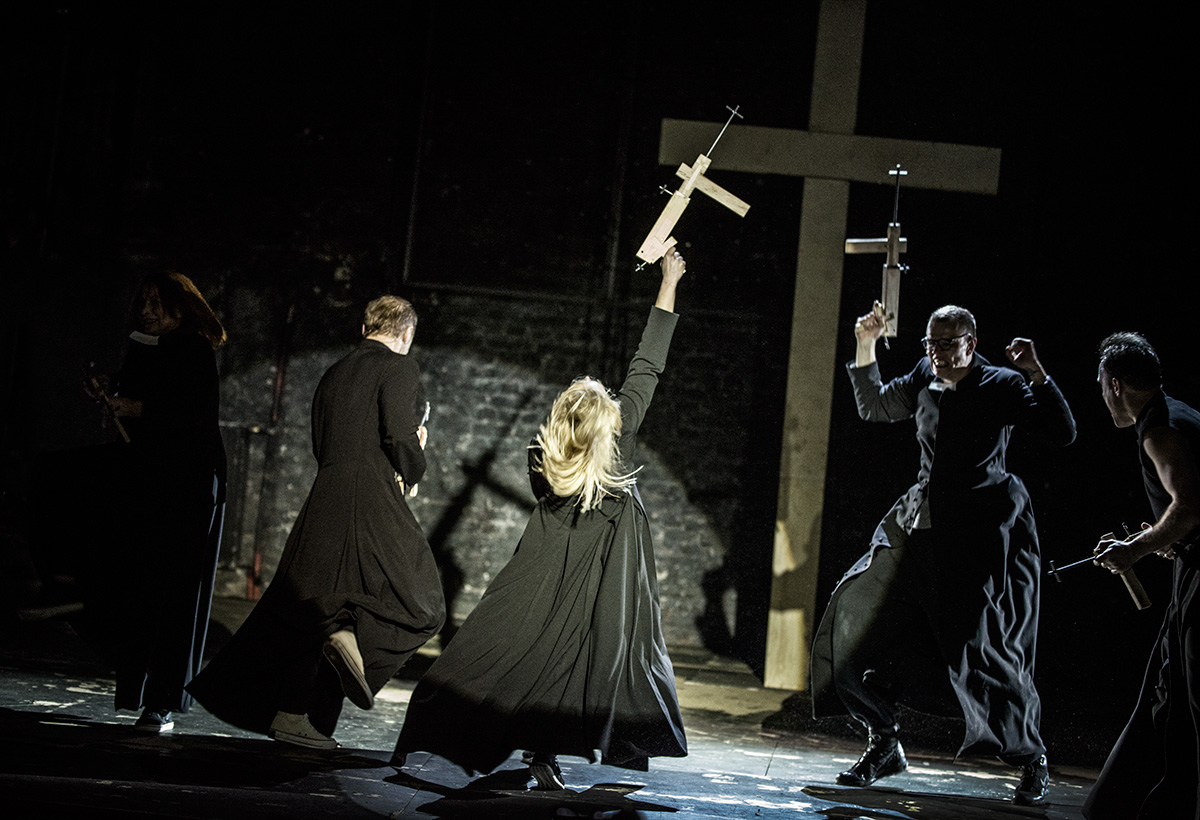Bryce Lease
‘What on earth is happening in Poland?’ a friend asked me in June 2017 after seeing a photograph of protestors setting off smoke bombs in front a Warsaw theatre. The image had been circulating around social media for several days. This was the reaction to Oliver Frljić’s controversial production of Klątwa (The Curse) at Warsaw’s Teatr Powszechny. My friend’s question is an important one today. What is happening in Poland? As images of public protests travel easily around the internet, I would like to argue that the response to Frljić’s production needs to be understood in a much wider context of political censorship and moral panic. Since the Law and Justice Party (PiS) came to power in 2013, five Polish artistic directors of major public theatres have not had their contracts renewed. In public ‘competitions’, local authorities have replaced critical directors with artists they see as more amenable. Polish critic Mike Urbaniak claims that PiS’ victory responded to the Polish right’s sense that theatres in Poland are ruled by the left and have insulted the nation, the Church, the flag, the cross, and have promoted sodomy. Such factions felt the theatres should be silenced.1
Photos from the protest by Katarzyna Laskowiecka
Examples of this trend are numerous and frightening. In 2016 at the Teatr Polski in Wrocław, Cezary Morawski replaced Krzysztof Mieszkowski, who was deemed ineligible to compete to retain his highly successful decade-long tenure at the theatre as he apparently had inadequate theatre training, meaning he had not attended a theatre academy. This change in leadership was met with a street protest with banners proclaiming ‘Teatr Polski – Not Morwaski’ and ‘Stop the Arrogance of Power’ and a public forum to debate the lack of transparency around the open competition for this role. At this event, it was claimed that the protest was not a political one, rather the theatre’s staff and key members of Poland’s theatre community agreed that Morawski did not have the competence to provide an adequate artistic program for the theatre. Morawski then sacked eleven members of the creative team, including actors and directors who had protested against him. The new artistic director accused them of insubordination, damaging the theatre and alienating or provoking audiences. Indeed, audiences have abandoned the formerly popular and politically engaged Teatr Polski.
The latest controversial – and frankly shocking – change came at the Stary Teatr (Old Theatre) in Kraków, considered by many the most important theatre in Poland. In 1991, the Stary Teatr was given the exclusive title ‘The National’ – the Teatr Narodowy (National Theatre) in Warsaw had been destroyed by a fire in 1985 and would not reopen until 1997 – a recognition of its significant status in Polish culture as the venue for serious discussion of national identity. Jerzy Got contends that the Stary Teatr, in contrast to Warsaw’s Teatr Narodowy (National Theatre) association with the aristocracy, was the first to be born out of a civil initiative that was middle class and democratically oriented. This honour placed an increased pressure on the theatre in the 1990s to commit to Poland’s future and show guidance in the new capitalist reality. Over the past five years, Jan Klata programmed some productions that have been openly critical of the current regime. Now he has also lost his job. The anxiety over the next potential victims of this political cull of engaged artists is visceral in Poland today. Warsaw is one of the last strongholds, and Urbaniak has advised audiences to attend Teatr Powszechny, TR Warszawa and Nowy Teatr while they still can.
After Klata canceled Frljić’s production of Nie-boska komedia (Un-divine Comedy) – which was intended to address anti-Semitism in Poland – at the Stary Teatr, the political storm blew to Teatr Polski Bydgoszcz (TPB). The TPB has had a robust political programme after Paweł Lysak took over as manager, who was then succeeded by Paweł Wodziński and his deputy director Bartosz Frąckowiak. The latter pair invited Our Violence and Your Violence to the theatre in 2016. One actor pulled the Polish flag from her vagina, a gesture that caused outrage and resulted in legal battles and impacted the city’s decision not to renew the artistic directors’ contracts in 2017.2
And so, why were there smoke bombs being set off in front of a theatre in the Praga district of Warsaw? Paweł Łysak proposed a controversial play for Frljić to stage at Powszechny. Klątwa (The Curse), written by neo-Romantic Stanisław Wyspiański in 1899, is based upon the real-life events of a local priest impregnating a young woman and abandoning her and the child to the judgment of their local community. Given its brutal depiction of the Catholic Church, the play has proved unpopular and was rarely staged in the twentieth century. Frljić accepted, explaining that Wyspisński’s text was radical in its contemporaneous moment. The director was particularly interested in examining the position of a woman in a strongly clerical, religious society, the political power of the Catholic Church, and the boundaries of freedom of artistic expression in a public theatre.3 According to director and dramaturg Weronika Szczawińska, Frljić’s production is the first to deal with the Church in the history of Polish theatre in such an open and direct manner. The theatre has been accused of blasphemous anti-Catholicism and has received vocal criticism from PiS, nationalists, conservative Catholics and the ONR. The organizers of the demonstrations wrote, ‘Passivity is enough for evil to win.’4 The theatre, in turn, issued a response that indicated the performance only reflected an artistic vision and that buying a ticket was a conscious choice. The freedom of artistic expression itself cannot be questioned.
Interestingly, on both sides of the argument we see how political performance (directly in a theatrical frame or in the performative frame of public protest) is reliant on the activation of voluntary members. It is the opposite of what is perceived to be ‘passivity’ and requires intentional participation. This argument breaks down, however, when such forms of participation are jeopardized. The National-Radical Camp (Obóz Narodowo-Radykalny, ONR) is a far-right nationalist non-political movement in Poland associated with the Polish National Movement. Tomasz Kalinowski, a spokesman for ONR, claimed that ‘Catholics have to take matters into their own hands’, after the Ministry of Culture ‘failed’ to take action against the production.5 In April and May 2017, this group attempted to block the entrance to the theatre in order to prevent spectators from attending the performance. Blocking access is confusing the right to freedom of speech with the exercise of power. In the pages of Krytyka Polityczna, journalist and film critic Jakub Majmurek refracts the arguments through the lens of the Polish constitution. Citing a number of constitutional articles, he demonstrates the complexity of the legal arguments that at times stand in potential conflict with one another, including the right to inherent dignity, principle of equality, prohibition of discrimination, the freedom of conscience and religion. He recommends an independent body who can analyse the case and asks when the ‘highest values of the Catholic Church became constitutional values’. Ultimately, he concludes, the task of a Minister of Culture in a liberal democracy is not to uphold religious values or to attribute these to the constitution, but rather to ensure that artists have the necessary conditions to discuss cultural values as such.
Wyspiański’s play is only a starting point for Frljić’s production. The spare set, stripped back aesthetics, and extreme lighting combine to make a startling and surgical interrogation of the impact of the Church on the individual, which moves between original text and postdramatic strategies of deconstruction, estrangement, and confrontation. Although this is a company of actors working in close collaboration, a series of divergent monologues highlights each of their experiences of intense isolation. These are confrontational, humorous, and moving in turn, all conveyed with staggering intimacy. Although postdramatic theatre often depersonalizes the actors’ and audiences’ relationship to a text, Frljić invited very personal responses from the Powszechny’s ensemble.
In the opening moments, the cast gathers together in a tight configuration to telephone Bertolt Brecht, who explains that they cannot do this play. He reminds the actors where they are. In Poland. They admit that they are uncertain how the audience will receive this work as a light shines over the auditorium. Anxiously, the actors look us over, deciding if it is safe to continue. Audience members have already crossed two boundaries to arrive inside the theatre. Firstly through the demonstrations against the performance that have been organized by the ONR, and secondly through police barriers where both our tickets and our persons were carefully scrutinized. The production premièred in February 2017, and the protests continued throughout the spring of that year when I first attended. As a result of these three points of scrutiny, this is the most publicly visible I have felt at any theatre performance I have attended in my life. The same is also true, no doubt, for the actors, who must cross through this line of demonstrators and deal with the various threats they continue to receive on a daily basis. Needless to say, both actors and audience are anxious. The police and the actors want to know what we look like. Are we threatening, or are we coalitional? Are we only curious, or are we suspect? And, ultimately, are we dangerous? Perhaps inevitably, this called to my mind the confrontation with US Vice President Mike Pence at the conclusion of a Broadway performance of the musical Hamilton in November 2016. The cast called upon the new administration to consider the rights of minorities. Trump tweeted the following day his outrage at this action. He claimed that the theatre ‘must always be a safe and special place’. What he indicated was that personal safety is at odds with open public debate, when actors as people rather than as characters challenge our political beliefs. I would argue that the protestors outside the Powszechny – like Trump and other populists – are equally wary of the theatre as a sphere for this form of open public debate, which is deemed unsafe.
There a number of ‘incidents’ in the performance that I had read in advance. Two of the most controversial staging choices frame the beginning and end. Once the actors decide that they will work with Frljić, they move into the world of Wyspianski’s text, if not directly into his language. As a representation of the priest’s seduction of the young woman, a large statue of John Paul II is dragged onto stage. He gazes down at the girl kneeling before him, his hands delicately clasped in prayer. Attached to his body is a long white dildo, onto which the girl first rolls a condom before performing fellatio for several agonizing minutes. This is not an erotic encounter, but one that feels forced and unequal. Her choice to use a condom is also a direct attack against the Polish pope’s strict stance against contraception. Through an overhead recording, we hear the voice of John Paul II. This disarticulation of his religious speech from his body foregrounds another departure between public (faith, good manners, decorum, sanctity) and personal (desire, power, manipulation, abuse) life that Wyspiański explores in his play. No small part of the shock of this stage image is the revelation that JPII has a penis at all, which is another consequence of the exposure of the private life and thoughts of a Catholic priest. Around the pope’s neck a sign is placed that reads ‘Obrońca Pedofili’ (Defender of Pedophiles) and a noose. By positioning these images at the outset of the performance, Frljić allows more room to interrogate questions around xenophobia, public perception of Muslims, sexual abuse of the clergy, and women’s rights later on.
In the following scene, the young girl who has given birth to the priest’s illegitimate child is played by another actor. Her face is painted with clown make-up as part of a ritual of submission that is intended to shame her. Until she is willing to offer not only her possessions and her baby but also her body – yet again – to the Church through the figure of the priest, her fellow parishioners admonish her. Shaking their heads, they repeat za mało (not enough). The role of the priest is also shared by several actors, who wear priestly robes in a mode that evokes both power and – for Arkadiusz Brykalski, whose muscular arms are revealed in a cut-off cassock – sexuality. Breaking these singular roles up amongst the ensemble moves the question of culpability for a particular action by a singular priest to a systemic problem of abuse. By empathizing with a visible singular victim, such an exposure would be dampened. This staging choice subjects the institutions of the Church to scrutiny, and also serves as a recognition of the victims who remain invisible.
An actress raises her shirt to show us 1000zł (ca. 230 Euros) written on her belly. This is the price a woman is paid by the government if she does not have maternity leave pay. As Agnieszka Jakimiak, a dramaturg on the production, pointed out, this is the symbolic price of giving birth in Poland. The actress asks the audience who has been pregnant – many women raise their hands – and then she asks who like herself has also had an abortion. It is not a confrontation, but a genuine question, again meant to break the silence and expose the lack of visibility over this cultural taboo. No one raises their hands at first, but the actor waits patiently. Eventually, a woman who appears to be in her sixties raises her hand in the row in front of me and she is thanked for her courage. Given her age, it occurs to me that it is likely she had an abortion under communism. After 1989, the most obvious signifier in the erosion of women’s rights was the devastating change in 1991 to the laws governing abortion, which had been both legal and freely available, along with contraceptives, to Polish women since 1956. It also marked the growth of patriarchal nationalism and Catholicism and the exclusion of women in leadership roles in the opposition movements that led the political transformations. After a fervent diatribe about the rights that she had, or should have, over her own body, I noticed a number of women (but, excluding myself, no men) applauding the actor. It occured to me in this moment that in the first two instances of inspection (the protestors, the institution) gender also determined the experience. I felt guilty for only realising this now.
Frljić himself is put under investigation by the actors. One of them turns to the audience and asks if Frljić’s theatre pleases us. They speak the word spektakl as a question, unsure whether this evening’s manifestation counts as a theatre production. They remind us about his canceled production in Kraków and the court case in Bydgoszcz that Our Violence and Your Violence sparked. They discuss the controversial programming of Rodrigo Garcia’s Golgota Picnic at Malta Festival in 2014, which prompted theatre directors, journalists, politicians, cardinals and bishops to participate in debates around censorship, freedom of expression, the violation of national blasphemy laws and the state of Polish and European democracy – when Catholics also gathered to protest and block access to selected theatres across the country, just as they were currently doing outside of this theatre. In 2017, Frljić was invited to curate the Malta Festival and the Minister of Culture, Paweł Gliński, threatened to cut the government’s portion of funding (300,000 PLN) if Frljić was not dismissed. Malta Festival refused, and Gliński made good on his threat. In a monologue, Barbara Wysocka highlights the way in which Frljić moderated his claim to authority as director. She, who is eight months pregnant, has to walk through the protestors and suffer death threats, while the director is in Germany already working on his next show. It is the actors who have to endure the very serious and very real consequences of Frljić’s provocation. Afterwards, another actor takes a photo of Frljić and cuts a hole where his mouth is. He then removes his trousers and inserts his penis into the director’s open lips, an inversion of the oral sex performed on the pope at the beginning of the performance. Now the actors are taking over control of the discourse, both linguistic and embodied. They are no longer at the mercy of the director’s choices or vision.
One actor accuses an audience member of being a Jew, an Arab, a pederast and then asks for another volunteer to commune with her. There is a panicked silence until she selects her next victim. Another performer wants to ask us for funds to assassinate a PiS politician. The actress did her own research on the law and found, as she explains, that she could be jailed for using language that incites violence. This references rather than replicates German director Christoph Schlingensief’s art action at the Documenta X exhibition in Kassel in 1997, in which he was arrested for carrying a placard with the words ‘Kill Helmut Kohl!’ Reminding us that this is the theatre and everything that happens within its frame is a fiction, she also cites the Criminal Code that prevents her from requesting money from the audience for the murder of Jarosław Kaczyński, chair of the Law and Justice Party. Again, we are made aware of the presence of the protestors outside the theatre. I wondered if they had also explored the legal limits of their attack on the Powszechny.
Photos by Magda Hueckel.
Although the performance starts with a crucifix, it does not end with one. As the audience filed into their seats the only visible object on the stage, peeled away from aesthetic trappings, was a very tall, simple, wooden cross. In the middle of the performance, crosses are used as weapons to explore the destructive, physical force of the Church. Crucifixes are used as hammers to furiously pound the stage floor, and then they are craftily fitted together to form machine guns, which the actors aim at the audience. In the final moments of the production, an actress slowly pulls on safety goggles, gloves, and protective overalls, before starting up a chainsaw and cutting the cross in half. When she pushes the sacred object to the floor, which it greets with a tremendous noise, the lights of the Polish eagle glow across the back wall of the stage. The actors calmly enter the stage, erect simple wooden ladders and begin the work of slowly extinguishing the individual white light bulbs that form this national symbol. It is a simple and deeply moving gesture. The work against nationalism. The action of coming to work every day through the line of protestors. The reminder outside the theatre that society is a disunified collective is not the problem. Nor, perhaps, is the fact that far more people will see this public performance of protest rather than the production that is being opposed. The problem is that the terms of the public debate have remained within a religious framework. The critics who have seen Frljić’s production and do not like it are resorting to critical terms that take a religious understanding of the world as their starting point. Temida Stankiewicz-Podhorecka, for instance, in the Catholic journal Nasz Dziennik, not only accuses the production of humiliating Poles, stifling their spirituality, patriotic feelings, and human dignity, but also argues that this is both pseudosztuka (pseudo art or play) and pseudospektakl (pseudo performance), claiming it is not an artistic work, that it has nothing to do with artistry, nor the term theatrical art.6 (Again, I am reminded of Trump, who in castigating both the actors and producers of Hamilton for their ‘bad behaviour’ also managed a swipe at the production itself, which he hears is ‘overrated’.7) The pseudospektakl does not ‘contain even the least truth about our reality’ and has been made by an incompetent amateur who has no idea about directing. Ultimately it works against her concept of culture. And here is the crux of her position, I believe. Just as Polish and Catholic are seen as a singularity, art and culture are being conflated. Given that the actors reveal very personal stories outside of the frame of character, it is rather astonishing that Stankiewicz-Podhorecka should claim that this offers no truth about ‘our’ reality. It is not surprising that she resorts to a tired nationalist comparison that foregrounds victimhood when she suggests that like Polish patriots in Prussian prisons she felt her dignity, humanity, and identity being stripped away. These are not artists, but rather ‘torturers’ that tried to ‘break [her] at all costs’. Her status as a victim is also matched with her radical passivity, in which she was unable to ‘make this vicious, insane attack stop’. Against such passivity, she calls on the Olgierd Łukaszewicz , former president of ZASP, the Polish Union of Stage Actors, to publicly condemn Klątwa. Critics who support the production, whether or not they like it, return to this idea of formal criticism. Maciej Nowak, director of Teatr Polski in Poznań, refuses the premise for any criticism of Klątwa that resorts to questioning its status as theatre, which all too quickly descends to the reductive binary of good or bad art. Calling on the classic American art theorist Author Danto, Nowak argued that art – and therefore theatre – is everything that people who deal with art recognise as art. In other words, politicians and radical rightwing protestors are not in the position to decide if this is real theatre. The definition of theatricality should be left to theatre makers.8
Paweł Łysak’s contract as artistic director at the Powszechny is up for renewal this year. Despite mayor of Warsaw Hanna Gronkiewicz-Waltz’s claim that he has the right to produce critical theatre and that audiences equally have the right to attend, it is possible that he will face the same fate as Mieszkowski, Wodziński, and Klata. Public theatres have to negotiate public funding, and programming Frljić has proven to be both a political and personal risk. In the post-89 political sphere, does this signal a return to censorship? Under neoliberalism, one no longer has to directly censor plays or productions, one only has to choose not to renew a contract.
Bryce Lease is Senior Lecturer in Drama & Theatre at Royal Holloway, University of London. He has published widely on Polish theatre, including his monograph After ’89: Polish Theatre and the Political (Manchester University Press, 2016). He is Assistant Editor for Contemporary Theatre Review, and Primary Investigator on the AHRC-funded project ‘Staging Difficult Pasts: Of Narrative, Objects and Public Memory’ (2018-21).
Notes:
- ‘Polska prawica uważa, że teatrami rządzą lewacy, których trzeba w końcu uciszyć’, Mike Urbaniak, Gazeta Wyborcza – Weekend online, 20 May 2017. ↩
- Fortunately, Wodziński and Frąckowiak went on to start an exciting new initiative, Biennale Warszawa, which combines political activism with performance and research. ↩
- Cited in Aneta Kyzioł, ‘Fałszywa moralność’, Polityka, 28 February 2017. ↩
- Cited in Michał Wojtczuk, ‘Warszawa. Narodowcy zapowiadają oblężenie Teatru Powszechnego’, Gazeta Wyborcza, 20 May 2017. ↩
- Cited in Jakub Majmurek, ‘Ministerstwo po stronie przemocy’, Krytyka Polityczna, 28 April 2017. ↩
- Temida Stankiewicz-Podhorecka, ‘Wynajęta miernota przeciwko Polakom’, Nasz Dziennik, 11 March 2017. ↩
- Donald J. Trump, ‘The cast and producers of Hamilton, which I hear is highly overrated, should immediately apologize to Mike Pence for their terrible behavior’, 20 November 2016. 3.22am. ↩
- Maciej Nowak, ‘Czy Klątwa to jeszcze teatr?’, Gazeta Wyborcza 08 March 2017. ↩


